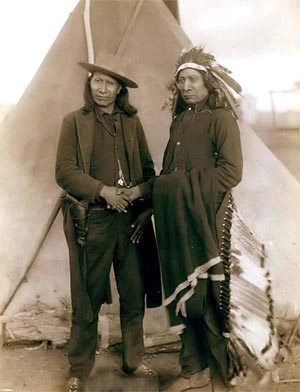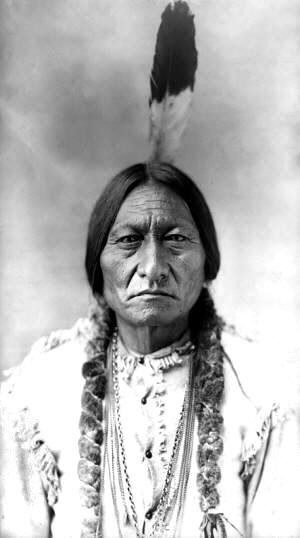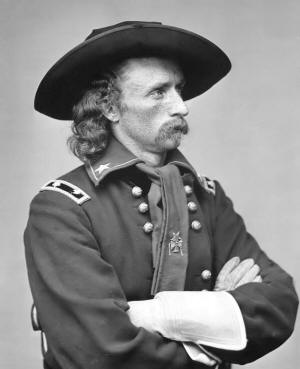|
out on their expedition of conquest west
of the Missouri. The Yellowstone river belonged to the Crows; the grassy
prairie of Nebraska was the home of the Pawnees; the Black Hills were
stomping grounds of the Cheyennes and Arrapahoes; the western side of
the Big Horn range and the broad valleys between them and the Rocky
Mountains were controlled by the Snakes; while roving parties of Crees
rode down along the north shore of the Missouri river itself.
With the Chippewas behind them, and with
the white settlers and soldiers in front, the Sioux waged relentless
war. They drove the Pawnees across the Platte all the way to Kansas;
they pushed both the Cheyennes and Arrapahoes out of the Black Hills,
and down to the head waters of the Kaw and the Arkansas rivers; they
fought the Snakes back into the Wind River Valley, with demands never to
cross the boundary of the Big Horn River; and they sent the Crows
running up the Yellowstone valley.
Brother against Brother: The Outbreak of the American
Civil War
When the Civil War broke out in 1861 the
Sioux aided the rebels considerably by raiding Northern settlements in
Minnesota, massacring hundreds of women and children, families which had
encroached on Sioux lands. General Sully was sent to punish them for
these attacks. He marched far into their territory, and would
fight them wherever he could find them, but it did no real good. The
attempts to keep the Sioux in check during the Civil War did consume
precious military resources. When the Civil War ended, and settlers
began to move west, further encroaching into Sioux territory, they found
the Sioux more aggressive than ever. The army was called on to protect
these pioneers, and to escort the surveyors and railroad workers. In the
years between 1866 and 1876, the cavalry had no rest; they fought year
round; and during those ten years of "peace" more army officers were
killed in combat with the American Indians than the British army
lost in the entire Crimean war. The Indians had always been brave and
skilled warriors, but in 1874 and 1875 the Sioux succeeded in arming
themselves with modern rifles, becoming a foe more dreaded than any
European cavalry. This combination of modern arms, incredible bravery,
and superb horsemanship created a formidable fighting force.
Treaties were made and broken with the
Sioux. A road had been built through the heart of the Big Horn and
Yellowstone. Wooden forts were built, and manned by small groups of
cavalry and infantry. From Ft. Laramie on the Platte up to the
Gallatin Valley only those little forts: Reno, Phil Kearny, and C. F.
Smith, guarded the way. Naturally the Sioux were concerned about these
settlements on their lands. One day vast hordes of Sioux gathered in the
ravines around Fort Phil Kearny.
Red Cloud
was the fearless Sioux leader. He sent a small raiding party to attack
the wood cutters from the fort, who were working with only minimal
military protection. Two companies of infantry and one of cavalry went
out to the rescue. They were quickly surrounded and then massacred.
After that the Sioux had undisputed dominion over their territory for
ten years. The US government's forts were burned and abandoned. The
allies of the Sioux joined with them, and a powerful nation of nearly
60,000 people ruled the country from the Big Horn River to the Union
Pacific Railway. The Sioux would not go south of the Union Pacific
Railroad.
Taking Cheyennes and Arrapahoes, who they
had intermarried with, the Sioux went back to the North Platte and the
territory beyond. From there they routinely raided in all directions.
Attempts were made by the Government to bribe them, but with no lasting
success. The U.S. established Indian Agencies and reservations at
convenient points. Here the old men, the sick, and the women and
children made their homes. Here the young warriors, laughing at the
White Man, filled up their bags with ammunition and supplies. They then
went on the war path, attacking any white settlers they could find.
They would return to the reservation when they needed more supplies.
Two large reservations were created
southeast of the Black Hills in the White River Valley. Red Cloud, the
hero of the attack at Phil Kearny, made his home here. Many of his
chiefs also gathered here: some "good", like
Old-Man-Afraid-of-his-Horses and his worthy son, but most of them crafty
and combative, like Red Dog, Little-Big-Man, and American Horse. Further
downstream, some twenty miles away, were the headquarters of the Brules.
Their chief, Old Spot, was loyal to the U.S., but he had no control over
the actions of the young warriors. Other reservations there were
along the Missouri, and the Interior Department wanted to gather all of
the Sioux Nation into these reservations, in order to help keep them out
of trouble, or so it was thought.
Proud Sioux Culture Demanded Something More Than
Reservation Life
The Sioux tradition, however, called for
deeds of bravery in battle in order to win distinction. The vacillating
policy of the US government allowed the Sioux warriors to make raids
against white settlers, and to then return to the sanctuary of the
reservation. |
|
Following Custer's trail, you will come
in sight of the Little Big Horn, snaking northward to its intersection
with the broader stream. Looking southward you will see the cliffs and
canyons of the mountains. To your North, the prairie reaches the horizon.
To your West you see a broad valley on the other side of the stream.
The fatal Greasy Grass is not seen below the steep bluffs that contain
it. The stream comes into sight far to the left front, and comes toward
you bordered by cottonwood and willow trees. It is lost behind the
bluffs. For nearly six miles of its winding course, it can not be
seen from where Custer got his first view of the village. Hundreds of
"lodges" that lined its western bank could not be seen. Custer eagerly
scanned the distant tepees that lay far to the North, and shouted
"Custer's luck! The biggest Indian Village on the Continent!" At this
point he could not have seen even 1/3 of the village!
But what he could see was enough to fire
the blood of a man like Custer. Huge clouds of dust, nervous horses,
frantic horsemen making a run for it, and down along the village, lively
turmoil an confusion. Tepees were being taken down quickly, and the
women and children were fleeing the carnage that was about to come. We
know now that the men he saw running westward were the young men going
out to round up the horses. We know now that behind those sheltering
bluffs were still thousands of fierce warriors eager and ready to meet
George Custer. We know that the indications of the Indians panicking and
retreating was due mainly to simply trying to get the families away from
the fight that was to come. The warriors were by no means running
from the fight, the brave warriors were making ready for battle!
Custer interpreted this confused scene as
the Warring Indians being in full and speedy retreat. Custer determined
that Reno should attack straight ahead, get to the valley and cross the
stream. Reno could then attack the southern end of the camp. This would
leave Custer and his companies to go into the long winding ravine that
ran northwestward to the stream, and then attack aggressively from the
east.
Custer sent a dispatch to Benteen and
MacDougall, notifying them of his actions, and ordering them to hurry
back with the pack trains, supplies, and extra ammunition. Custer placed
himself at the head of his column, and charged down the slope, with his
troops close behind. The last that Reno and his people saw of Custer was
the tail of the column disappearing in a cloud of dust. Then only
the cloud of dust could be seen hanging over the trail.
Moving forward, Reno came quickly to a
gully that led down through the bluff to the stream. A quick run brought
him to the ford; his soldiers plunged through, and began to climb the
bank on the western shore. He expected from his orders to find an
unobstructed valley, and five miles away the lodges of the Indian
village. It was with surprise and grave concern that he suddenly rode
into full view of a huge camp, whose southern border was less than two
miles away. As far as he could see, the dust cloud rose above an excited
Indian Camp. Herds of war horses were being run in from the west.
Old men, women, children, and ponies were hurrying off toward the Big
Horn. Reno realized that he was in front of the congregated
warriors of the entire Sioux Nation in preparation for battle.
Most people think that Custer expected
Reno to lead a dashing charge into the heart of the Indian Camp, just as
Custer had done at Washita. Reno did not dash as Custer had
expected. The sight of the Assembled Sioux Nation removed any
desire Reno had ever had to dash into the camp. Reno attacked, but the
attack was tentative and half-hearted. He dismounted his men, and
advanced them across a mile or so of the prairie. He fired as he
got within range of the village. He did not meet any resistance.
The appearance of Reno's command apparently came as a surprise to the
Uncapapa and Blackfeet, who were on the South side of the camp. The
scouts had given sign of Custer's troops coming down the ravine.
Those who had not run for cover were apparently running toward the Brule
village, anticipating that Custer would strike there first.
Reno could have charged into the south
end of the village before his approach could have been recognized.
Instead, he approached slowly on foot. Reno had had no
experience in fighting Indians. He simply concluded that his small
column would not drive the mass of warriors from the valley. In
much trepidation, he sounded a halt, rally, and mount. He then paused,
as if he did not know what to do.
The Indians correctly sensed his
hesitation, fear, and indecision. He lost the element of surprise,
he lost his momentum, and he lost the confidence of his own troops. He
emboldened his enemy; "The White Chief was scared"; and now was
their opportunity. Warriors, men and boys, came tearing to the location.
A few well-aimed shots knocked some men off of their horses. Reno
quickly ordered a movement by the flank toward the bluffs across the
stream to his right rear. He never thought to dismount a few cool guns
to turn around and cover the enemy. He placed himself at the new head of
column, and led the retreating movement. Out came the Indians, with
shots and triumphant yells. The rear of the column began to overtake the
head; Reno was walking while the rear was running. The Indians came
dashing up on both flanks and the rear. At this point the poorly led and
helpless troops had no choice. Military discipline and order were
abandoned. In one mad rush they ran for the river, jumped in,
splashed through, and climbed up the steep bluff on the eastern shore --
an inexcusable panic, due mainly to the incompetent conduct of a
cowardly commander.
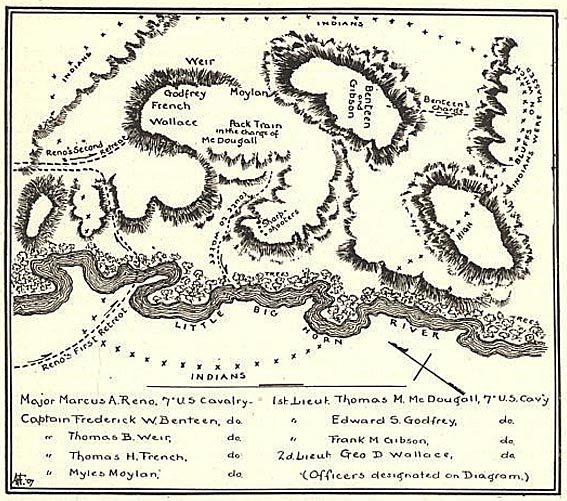
Battle Map of the Battle of Little Big Horn
In vain several of the best officers of
the column (Donald McIntosh and Benny Hodgson) tried to rally and
protect the rear of the column. The Indians were not in overpowering
numbers at that point, and a bold stand could have saved the day. But
with the Major on the run, the Lieutenants could do nothing, but die
bravely, and in vain. Donald McIntosh was surrounded, knocked from his
horse and butchered. Hodgson, shot off his horse, was rescued by a
friend, who dove into the river with him, but close to the farther shore
the Indians killed him, a bullet tore through his body, the gallant and
brave man rolled dead into the muddy waters.
Once well up the bluffs, Reno's command
turned around and considered the situation. The Indians had stopped
their pursuit, and even now were retreating from range. Reno fired his
pistol at the distant warriors in useless defiance of the men who had
stampeded him. He was now up some two hundred feet above them, and it
was as safe as it was harmless. Two of his best men lay dead down on the
banks of the river, and so did more than ten other of his soldiers.
The Indians had swarmed all around his troops, and butchered them as
they ran. Many more had been wounded, but things appeared safe for the
moment. The Indians had mysteriously retreated from their front. Reno
did not know what it meant, did not know what had happened to Custer,
and did not know where the commands of Benteen and MacDougal were.
Over toward the villages, which they
could now see stretching for five miles down the stream, all was total
pandemonium and confusion; but northward the bluffs rose still higher to
a point nearly opposite the middle of the villages -- a point some two
miles from them -- and beyond that they could see nothing. But that is
where Custer had gone, and suddenly, splitting through the moist morning
air, came the sound of loud and rapid gunfire; complete volleys followed
by continuous rattle and roar. The sounds of war grew more intense for
the next ten minutes. Some thought they could hear the victory yells of
their friends, and they were ready to yell in reply. Others thought they
heard the sound of "charge" being blown on the trumpets. Many
wanted to mount their horses, and join the fight, which sounded to be
just over the bluffs.
But, almost as suddenly as it had
started, the sound of gunfire faded away. The continuous peals of
musketry settled into sporadic skirmishing fire. Reno's men looked
at each other in confusion. They could not figure out what had just
happened.
Reno's men were soon encouraged as they
heard the reports of scouts that Benteen and MacDougal were approaching
from the east. When they arrived the first thing they asked was, "Have
you seen anything of Custer?"
Benteen and Weir scouted up to a mile or more to the north, had
seen swarms of Indians in the valley below, but not a sign of Custer and
his cavalry.
They concluded that there would be no
help from Custer, and they did the only thing they could under these
circumstances; they dug in and would try and hold out until Terry and
Gibbon got there. Reno did not have the pack train, which gave him ample
ammunition and supplies.
The question remained, what had happened
to George Custer and his men? The question can only be answered by the
Indians who were victorious that day, and one Indian who had been
working for Custer. There was one Crow scout in Custer's command
who managed to escape the carnage of that day in a Sioux blanket.
Between the lone survivor of Custer's command, and the victorious Indian
warriors, a fairly consistent story emerges. From all these sources it
was not hard to trace Custer's every move during that fateful battle.
Custer's Last Stand
Never comprehending the overwhelming odds
against him, believing that the Indians were "on the run", and thinking
that between himself and Reno he could "double them up" in short order,
Custer had sealed his fate. It was about five miles from where Custer
first saw the northern end of the village and where he attacked the
center of the village. During this 5 mile ride, Custer never saw
the complete magnitude of the Indian Camp. As he attacked, and
rounded the bluff, he found himself confronted with thousands skilled
and well equipped warriors, all ready for the fight. He had hoped to
attack the center of the village unmolested, and to meet Reno's men
there, coming from the other direction. Instead he faced an intense
attack from the thickets and trees. He could not ignore the
attack, and had to deal with the threat at hand. He had his men
dismount, and begin engaging the fire coming from the thickets.
This was a perilous move, as he was outnumbered ten to one at this
point. Worse than that, hundreds of young braves had mounted their
horses and dashed across the river below him, hundreds more were
following and circling all about him. It is likely that this is the
point that Custer realized that he was in trouble, and that he must cut
his way out and escape the overwhelming enemy surrounding him.
His trumpeters sounded "Mount!", and
leaving many injured companions on the ground, the men ran for their
mounts. With skill and daring, the Ogalallas and BrulÚs recognized the
opportunity, and sprang to their horses, and gave chase. "Make for the
heights!" must have been Custer's order, for the first dash was
eastward, and then more to the left as their progress was blocked.
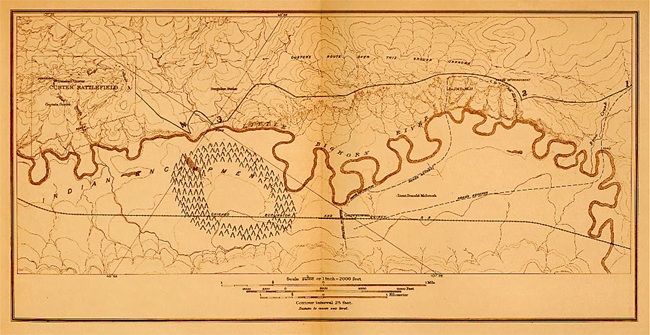
Map of Custer's Last Stand
Then, as Custer and the remainder of his
regiments of 7th cavalry reached higher ground, they must have fully
realized the gravity of their situation. For from this vantage
point, all they would have been able to see would be throngs of skilled
Sioux warrior on horseback, circling and laying down a furious fire.
Custer and his command was fully hemmed in, cut off, and losing men
quickly. Custer must have realized that at this point retreat was
impossible. Some of the Indian victors later reported that at this
point Custer ordered that the horses be turned loose, after losing about half of his men.
A skirmish line was then formed down the
slope, and there the men fell at 25 feet intervals (It was here that
their fellow soldiers found them two days later). At last, on a
mound that stands at the northern end of a little ridge, Custer, Cook,
Yates, Tom Custer, and some dozen other soldiers, (the only white men
left alive at this point), gathered for the last stand. They undoubtedly
fought fiercely, but lost their lives to the superior numbers, and
superior leadership and strategy of the Indian Nation.
Keogh, Calhoun, Crittenden, had all been
killed along the skirmish line. Smith, Porter, and Reily were found dead
with the rest of their men. So were the surgeons, Lord and De Wolf; and,
also, were Custer's other brother, "Boston" Custer and the Herald
correspondent.
Two men were not found among the dead.
Lieutenants Harrington and Jack Sturgis. About 30 men had made a run for
their lives down a little gully. The banks of the gully were teamed with
Indians, who managed to shoot down the escaping soldiers as they ran.
One officer was reported by the Sioux to have managed to break through
the deadly circle of Indians, the only white man to do so that day. Five
warriors gave chase. It is reported that as the pursuing band was
worn down, and giving up the chase, the officer concluded that all was
lost, and took his pistol, and shot himself in the head. This
soldiers skeleton was pointed out to the officers of the Fifth Cavalry
the following year by one of the pursuers. It had not been found before
then. Was it Harrington or could it have been Sturgis? Some years later
yet another skeleton was found even further from the battle scene.
Remnants found at the scene indicated that it was a cavalry officer.
If so, all the missing would be accounted for.
The Sole U.S. Army Survivor
Of the twelve troops of the Seventh
Cavalry, Custer led five that hot Sunday into eternity and infamy at the
battle of the Little Big Horn, and of his part of the regiment only one
living thing escaped the deadly skill of the Sioux warriors. Bleeding
from many arrow wounds, weak, thirsty and tired, there came
straggling into the lines some days after the fight Keogh's splendid
horse "Comanche". Who can ever even imagine the scene as the soldiers
thronged around the gallant steed?
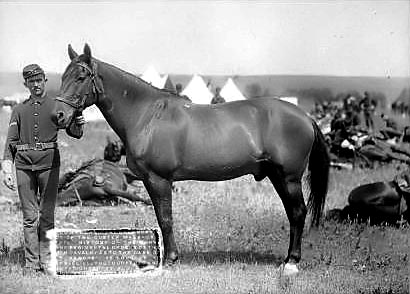
Comanche- The only US Army Survivor at the Battle
of Little Big Horn.
Editorial Note: There are endless descriptions referring to this
horse "Comanche" as the "only survivor of the Battle of Little Big
Horn". Please remember that there were thousands of brave and
victorious survivors among the Indian Nations. They won the battle
and they survived the battle. They were fighting for their lands,
their family, and maybe most of all, for their way of life. In the end,
their cause was lost, and their battle in vain, but we must remember,
and honor their skill, bravery, and honor at this great event in our
history.
As a tribute to his service and bravery,
the war horse Comanche was never ridden again. He was stabled at Fort
Riley, and would periodically be paraded by the US Army. He lived to the
age of 29, and when he died his body was mounted and put on display at
the University of Kansas, where it stands to this day.
With Custer's men all dead, the
triumphant Indians left their bodies to be plundered by their women. The
warriors once more focused on Reno's front. There were two nights
of celebration and rejoicing in the Indian Camp, though not one instant
was the watch on Reno eased. All day of the 26th they kept him penned
down in his rifle pits. Early on the morning of the 27th, with great
excitement, the lodges were suddenly taken down, and tribe after tribe,
village after village, family after family, six thousand Indians passed
before his eyes, moving towards the mountains.
Terry and Gibbon had arrived. Reno's
small remnant of the 7th cavalry had been saved. Together they
reconnoitered the battlefield, and hastily buried their fallen comrades.
They then hurried back to the Yellowstone while the Sioux were hiding in
around the Big Horn. The Indians were shrewd enough to realize
that Crook and Terry would be reinforced. They also realized that
their victory would result in the US Army relentlessly pursuing them. As
they heard that great numbers of troops were assembling near the
Yellowstone and Platte, they took the only reasonable strategy that they
could; the great Alliance of Indian Nations quietly dissolved.
Sitting Bull, with many close associates, made for the Yellowstone, and
was driven northward by General Miles. Others took refuge across the
Little Missouri, where Crook pursued. With much hard pursuit, and even
harder fighting, many bands and many famous chiefs were forced into
submission that fall and winter. Among these, bravest, most
skilled, most victorious of all, was the hero of the Powder River
battle, the famed warrior Crazy Horse.
The fame of Crazy Horse, and his exploits
had become the stuff of legends among the Indian camps along the
Rosebud, even before he joined Sitting Bull. He was a key part of
the battle with General Crook on June 17. No chief was as honored or
trusted as Crazy Horse.
Up to the time of Little Big Horn,
Sitting Bull had no real claims as a warrior, or as a war chief. Eleven
days before the fight Sitting Bull had a "sun dance." His own people
report that while he was in a trance, he had a vision of his people
being attacked by a large force of white men, and that the Sioux would
enjoy a great victory over them. The battle of the 17th of June
was a partial fulfillment of this vision.
Scouts in the Indian Camp had seen Reno's
column approaching, but it was decided that nothing would come of that.
Sitting Bull believed that the army was waiting for reinforcements, and
he had no expectations that an attack was imminent. Then on the morning
of the 25th, two Cheyenne Scouts came running into camp, indicating that
a large group of soldiers was approaching. Undoubtedly, this led
to the commotion that Custer misread as a panic retreat.
Of course, such a report would mean that
the women and children had to be hurried away, the great herds of horses
brought in, and the warriors assembled to meet the coming adversary.
Even as the great chiefs were running to the council lodge there came
the report of gunfire from the south. This was Reno's attack, which the
Indians were not expecting. It is reported that the unexpected
attack of Reno, and the report that "Long Hair" was dashing up the
ravine was too much for Sitting Bull. He is reported to have gathered
his family and made his escape to safety. Several miles from the battle,
he realized that he was missing one of his children. As he began to
return for the missing child, he was surprised to hear the battle
waning, and everything becoming quiet. He returned to camp in
about 30 minutes, where he found his child. He also found that the
battle had been won in his absence.
Without him the Blackfeet and Uncapapas
had pushed Reno back and penned him on the bluffs. Without him the
Ogalallas, BrulÚs, and Cheyennes had repulsed Custer's daring assault,
then rushed forth and completed a circle of death that consumed Custer,
and all the men with him. Again, it was Crazy Horse who was foremost in
the fray, riding in and clubbing the bewildered soldiers with his
immense club of war.
On this day, Sitting Bull's vision was
fully realized, but he was not there. Some loyal followers claimed that
he had directed the battle from the lodge. The truth lay in the
names given to Sitting Bull's twins- "The one that was Taken", and "The
one that was Left".
In the years after the conflict, many
warriors would tell of their great exploits in the great battle. Rain in
the Face would even brag that he had killed Custer with his own hand. In
the midst of all the bravado and story telling one man emerged as the
man most respected by his comrades on that glorious day. The man most
respected by the Indians on that day, for his bravery and leadership,
was Crazy Horse. Crazy Horse was killed not long after the battle
as he tried to escape Crook's guard. |
